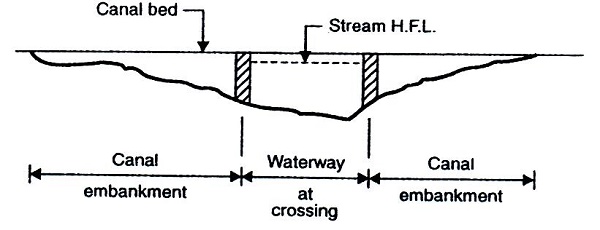Chapter: Civil : Water Resources and Irrigation Engineering : Canal Irrigation
Selection of Suitable Cross Drainatge Structure
SELECTION OF SUITABLE CROSS DRAINATGE STRUCTURE
Relative differences in bad an water levels of a canal with those of the crossing stream as their discharges are the main factors for deciding the types of crossdrainage structure site. By suitably caning the alignment of the canal between off taking point A and watershed the relative difference between the bed levels of the tributaries and canal at the crossing site can be al6tered. Consider three possible alignments ABC, ADE, a AFG of a canal taking off from a river at A and intersecting a tributary HBDFI at B,D, and before mounting watershed at C, E, and G, respectively figure. The distances AB, A and AF are almost the same and, hence, the canal reaches the crossing site with its bed m or less at the same level. But the bed levels of the tributary is highest at B, and the lowest at F in the reach BDF. Thus, if F is a suitable crossing site aqueduct, site D may necessitate the construction of a siphon aqueduct of level crossing and site B may require the construction of a siphon or a super passage. Thus, the type of cross drainage structure can be changed by suitably altering the crossing the site.

Figure: different canal alignments
between off take and watershed.
When the
crossing site is such that the canal FSL is well above the stream HFL the
choice between aqueduct and siphon aqueduct is made depending on the stream
discharge. For larger stream discharges (i.e., when the stream bed is much
wider) an aqueduct is more suitable than a siphon aqueduct which requires
lowering of the stream bed by a drop. Besides being costly, lowering of the bed
may result in silting on the lowered stream bed which increases the risk of
failure. However, an aqueduct necessitates heavy canal embankments towards the
crossing. This is due to the wide flood crosssection of streams in plains and
the acquirements that the canal must be well above the HFL, and the aqueduct
has aqueduct has to be constructed a smaller part of the crosssection of the stream.

Figure: Canal embankments near
crossing site
Siphon
aqueducts are more suitable when the stream size is small compared to the canal
size. In case of siphon aqueducts, the relative differences of water and bed
levels of the canal with those of the crossing stream is small and, hence,
embankments of only small height required.
If the
stream HFL is well above the canal FSL, super passage is generally preferred in
parison to siphon as the latter involves considerable head loss in the canal.
In addition, the struction of a siphon under a stream with an readable bed
requires heavy protection works. Foundations of the super passage and siphon
have to be carried up to much below the dibble bed of the stream. A separate
bridge across the stream trough has to be provided to try the canal road across
the stream. The construction of these structures is relatively difficult costly
due to the requirements of extensive training works and large stream trough to
try the high flood discharge. If the canal serves navigation needs also, then
sufficient headway would be provided for the passage of boats.
If the
bed and water levels of the canal and stream at the crossing site are
approximately same, a level crossing is provided. Sometimes, due to prohibitive
costs of siphons and aqueducts, the canal alignment between the off take and
watershed is suitably altered hat the level crossing can be provided at the
crossing site. The initial cost of a level crossing generally much lower than
the cost of other crossdrainage structures. Also, the perennial charge of the
stream can be diverted to the canal to provide additional irrigation. However,
level crossing requires permanent staff for continuous watch, maintenance, and
operation hates. Also, when the stream is passing the high flood discharge, the
canal may have to be down to prevent the sediment load of the stream from
entering the canal and silting it. There, if the canal FSL is higher than the
general ground level, the HFL of the stream would ease on the upstream side of
the crossing site causing submergence of the land. To prevent submergence of
the land, marginal banks are provided.
In addition
to the above factors, the topography of the terrain, foundation conditions, me
of the stream, and dewatering requirements would also affect the choice of the
type of sdrainage structures. Detailed examination of the terrain topography
and the foundation necessary to locate a stable reach of the stream with good
foundations and permitting early a rightangled crossing. For streams carrying
high sediment discharge, the possibility coking up of the siphon and the effect
of fluming of the stream should be kept in mind. Altering of foundations is
necessary in the construction of foundations for crossdrainage structures. An
accurate estimate of the cost and method of dewatering must be work when design
involves lying of foundations below the ground water table.
Related Topics